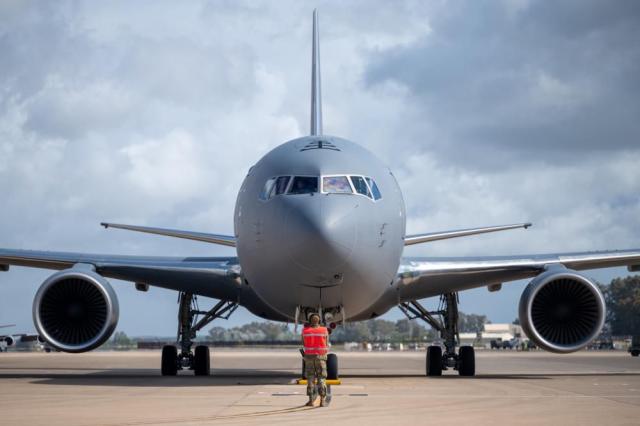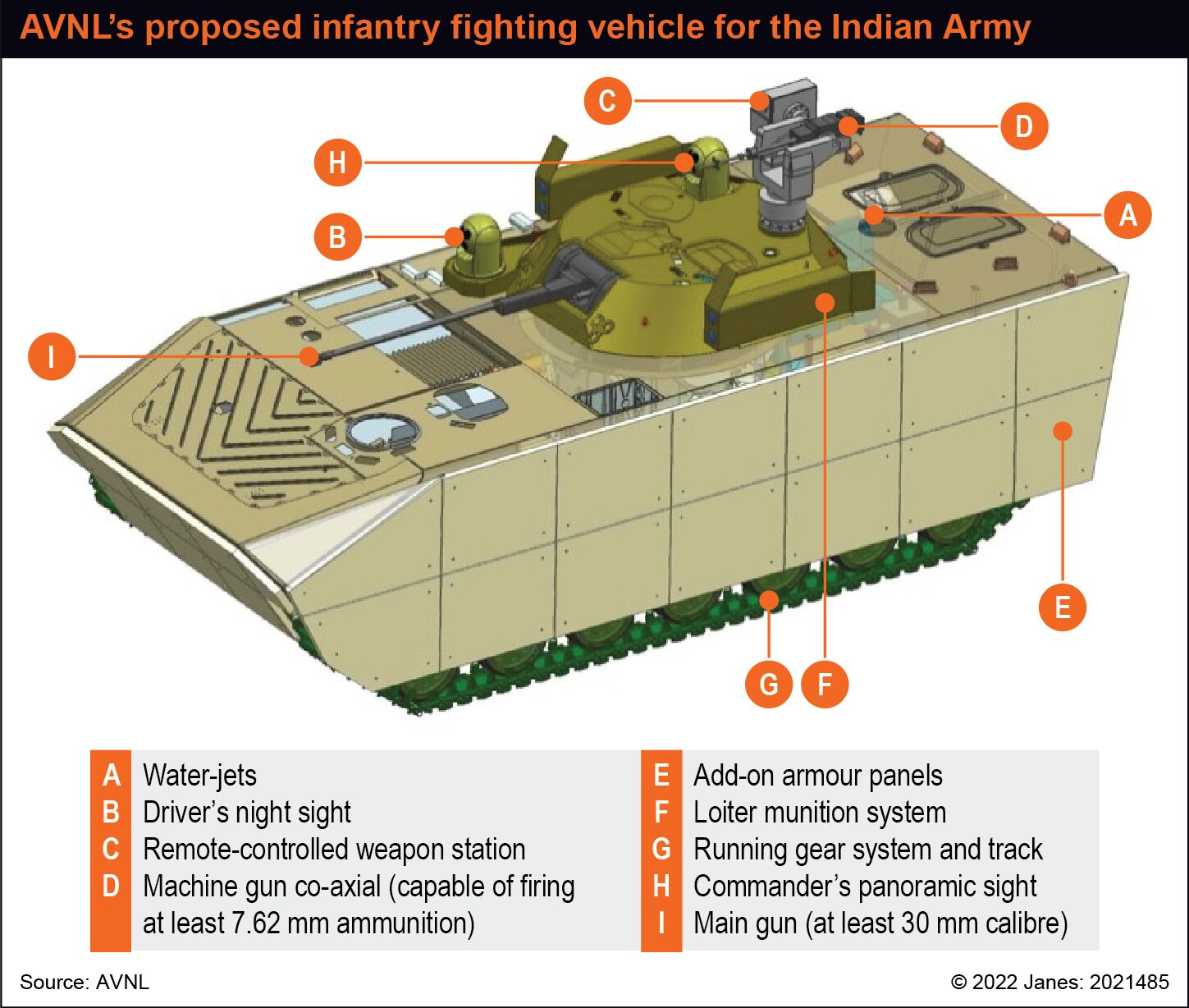SOURCE: RAUNAK KUNDE / NEWS BEAT / IDRW.ORG

While Hindustan Aeronautics Limited (HAL) is planning to float a global tender to purchase second-hand B-767s from the market, Boeing is planning to offer fully developed new mid-air refuellers based on the same aircraft called KC-46 Pegasus to the Indian Air Force at upcoming Aero India 2023 to be held at Yelahanka Air Force Station.
Boeing is planning to offer Foreign Military Sales (FMS) format for the deal to be concluded between both governments for the purchase of six mid-air refuellers. HAL tied up with Israel Aerospace Industries (IAI) in April to convert used B-767s into mid-air refuellers and delivery the first aircraft by 2025 onwards.
Continue readingSOURCE: RAUNAK KUNDE / NEWS BEAT / IDRW.ORG

India’s TAPAS BH-201 medium-altitude long-endurance (MALE) unmanned aerial vehicle (UAV) crossed a milestone by reaching an altitude of 28,000 feet and an endurance of 18 hours and soon will be demonstrating its final milestone which is to reach an altitude of 30,000 feet with an endurance of 20 hours endurance.
Tri-service will start getting 6 production models of TAPAS BH-201 UAV from April 2023 onwards that will be used for user trials and evaluation that DRDO plans to complete by end of 2023.
Continue readingSOURCE: RAUNAK KUNDE / NEWS BEAT / IDRW.ORG

According to a report in ” The Print “, the Indian Navy has submitted its report to the Defence Ministry and according to their sources, Dassault Rafale Marine offer is the frontrunner to bag the deal for 27 deck-based fighter jets to be operated from the Indian aircraft carrier as it meets all the Criteria.
idrw.org previously reported that Dassault has been offering better discounts and more upgrades to mitigate any chances of Boeing bagging the deal for its F-18 Super hornet. Both companies have been seen carrying out intense lobbying in the last few weeks after the completion of the evaluation of both jets from the shore-based facility in Goa.
Continue readingSOURCE: RAUNAK KUNDE / NEWS BEAT / IDRW.ORG

India’s state-run Armoured Vehicles Nigam Limited (AVNL) will roll out a Futuristic Infantry Combat Vehicle (FICV) in 2024 around Defence Expo 2024 as per a report in the ” Janes Intel”. The company official claimed that FICV unlike in previous attempts won’t be based on the Russian BMP infantry combat vehicle (ICV), but will be a new design.
FICV Prototype will be powered by a 600hp engine with automatic transmission and will have a standardization agreement (STANAG) level four protection and active protection system.
Continue readingSOURCE: RAUNAK KUNDE / NEWS BEAT / IDRW.ORG

Hindustan Aeronautics Limited (HAL) has been using the company-owned Hawk-i, an upgraded aircraft based on the baseline Hawk Mk132 to develop new sub-systems for modifications and obsolescence management of avionics systems as part of the Hawk upgradation program, which will be the source of many of the technologies that will find its way into the upcoming HLFT-42 aircraft.
HLFT-42 will be getting many of the systems like indigenous Mission Computers, Embedded Virtual Training Systems (EVTS), Softnet Radio, cockpit Human Machine Interface (HMI), and Digital Map Generation (DMG) from the Hawk-i Program.
Continue readingSOURCE: RAUNAK KUNDE / NEWS BEAT / IDRW.ORG

Saab’s Gripen team has met many potential partners that could be involved in the manufacturing of the Gripen-E fighter jet in India under the MRFA tender for 114 jets if it wins the tender. Aerospace companies from Bangalore, Hyderabad, and Chennai have met that included companies like Mahindra Defence and VEM Technologies.
idrw.org has been told that MoU regarding partner selection might take place on the sidelines of the Aero India that is to be held between 13th – 17th February 2023. at Air Force Station, Yelahanka, Bengaluru.
Continue readingSOURCE: API

The Indian indigenous aircraft carrier INS Vikrant has begun trials of the Swadeshi Empresa developed Sprint Fire fighting bot, which detects the source of a fire and extinguishes it with a water/foam jet/spray, keeping humans safe.
PM Narendra Modi launched SPRINT as part of the AzadiKaAmritMahotsav during the Naval Innovation and Indigenisation Organization Seminar Swavlamban.
Continue readingSOURCE: RAUNAK KUNDE / NEWS BEAT / IDRW.ORG

@Archit_Ch
Hindustan Aeronautics Limited (HAL) plans to display a scale model of the upcoming Hindustan Lead-in Fighter Trainer (HLFT-42) aircraft that it wants to offer as a low-cost Lead-in Fighter Trainer for the Indian Air Force (IAF) and also compete in International markets against Korean T-50 and Chinese Hongdu JL-10 Lead-in Fighter Trainer aircraft.
At first look, it seems it has small strakes attached to the air intakes that give it a familiar look to the air intakes that were there in the HF-24 fighter aircraft that was first developed in the early 60 by HAL under the guidance of German Kurt Tank.
Continue readingSOURCE: RAUNAK KUNDE / NEWS BEAT / IDRW.ORG

Indian Navy is taking quite an interest in HAL’s development of a Loyal Wingman program for the Indian Air Force (IAF), Navy has shown interest in acquiring deck-based Loyal wingman that can participate in operations along with Manned aircraft like TEDBf in near future.
Top Indian Naval Aviators are convinced that Aerial combat is headed toward a manned-unmanned teaming approach like artificial intelligence-driven wingman. idrw.org has been told that while the Navy is watching HAL’s Loyal wingman programs it will be on board when most of the technology is developed so that transition to a deck-based variant can be easily achieved.
Continue readingSOURCE: RAUNAK KUNDE / NEWS BEAT / IDRW.ORG

Boeing is likely to announce a partnership with Hindustan Aeronautics Limited (HAL) and Mahindra Defence Systems (MDS) for manufacturing the F-15EX Eagle-II fighter aircraft for the Indian Air Force’s Multi-Role Combat Aircraft (MRCA) competition in India if it wins the tender. Boeing has withdrawn its F/A-18 Super Hornet for IAF after Boeing received a license from the US Government to provide F-15EX fighter aircraft to the Indian Air Force (IAF) in January 2021.
MoU between firms might be concluded at the upcoming Aero India 2023 that is to be held between 13th – 17th February 2023. at Air Force Station, Yelahanka, Bengaluru.
Continue readingSOURCE: RAUNAK KUNDE / NEWS BEAT / IDRW.ORG

BDL recently signed an MoU With Dassault Aviation that could pay way to integrate India’s locally developed Astra Beyond Visual Range air-to-air missile into its Rafale fleet. BDL and IAF require source code authorization of Dassault Aviation so that the weapon fire control systems and fire control radar can communicate with the missile for which new software needs to be written, tested, and validated, and then it moves towards the carriage trials phase.
OEM often maintains total control of the source code and each Indian weapon that needs to be integrated into the Rafale needs to be vetted and cleared by the OEM due to which process is lengthy and it is unlikely Astra integration will not be complete by 2025.
Continue readingSOURCE: RAUNAK KUNDE / NEWS BEAT / IDRW.ORG

In 2020, without much fanfare, the Indian Navy along with National Technical Research Organisation (NTRO) launched a research vessel and missile range instrumentation ship built by Hindustan Shipyard Limited (HSL) called INS Dhruv. It was the first ship of its kind but won’t be the last of its kind, as the Indian Navy plans to expand its fleet of spy ships that can detect incoming hostile missiles.
idrw.org has been told that at least one more sister class of the ship has been proposed and might be cleared for induction sometime in near future. The idea is also to develop more sophisticated surveillance systems that can be mounted on bigger vessels to act as a force multiplier and provide a 360-degree view of the Indo-Pacific and the strategically important Indian Ocean region (IOR).
Continue readingSOURCE: RAUNAK KUNDE / NEWS BEAT / IDRW.ORG

Dassault Aviation seems to be on a slippery slope when it comes to the Rafale Marine jet due to severe limitations that have made the F-18E/F Super Hornet much more attractive while the Indian Navy brainstorms which aircraft will suit its operational requirements. French Defence Minister Sebastien Lecornu who was in India and even visited the indigenous aircraft carrier INS Vikrant hinted at providing various concessions to the Indian side.
idrw.org has been told that Dassault and France will be offering Rafale Marine at a much more discounted price and have offered to upgrade it to the same standards as IAF’s Rafale fleet with more Indigenous Indian content.
Continue readingSOURCE: RAUNAK KUNDE / NEWS BEAT / IDRW.ORG

The German government which had kept TKMS away from Indian tender for six advanced submarines under Project-75 India said that if the Indian Navy and Ministry of Defence (MoD) is willing to remove certain liabilities clauses that could have been levied if there were delays in the delivery of the submarines, it could consider sending its proposals, after Indian have had to extend the bid twice this year to August 2023.
ThyssenKrupp Marine Systems (TKMS) developed Type 214 submarines that met all the technical criteria set by the Indian Navy including the operational Air Independent Propulsion (AIP) module. TKMS claims that it will not be fully in charge of the local manufacturing of the submarines in India so it can’t be made liable for any delays that might happen in the program while it is been executed by an Indian shipyard.
Continue readingSOURCE: RAUNAK KUNDE / NEWS BEAT / IDRW.ORG

India will have four operational nuclear-powered ballistic missile-carrying submarines become operational by 2026 as a second (S3) SSBN is likely to become operational in the Indian Navy next year, which will be followed by a third (S4) and a fourth (S4*) submarine by 2026. India’s 3rd generation S5 class submarine program might enter the production stage sometime in 2027 onwards.
The S5 program officially started in 2015 and In 2019, a hydrodynamic test model of a submarine leaked online that didn’t resemble any other older design suggesting considerable initial work has been carried out. S-5, a 13000-ton displacement submarine will require a new bigger dockyard at Ship Building Centre (SBC) in Visakhapatnam before production work commences.
Continue reading